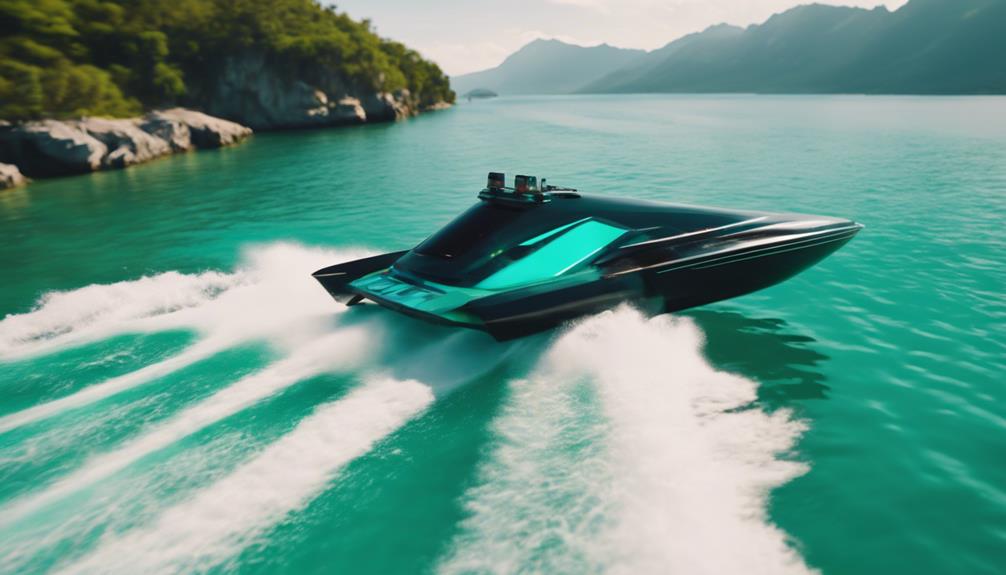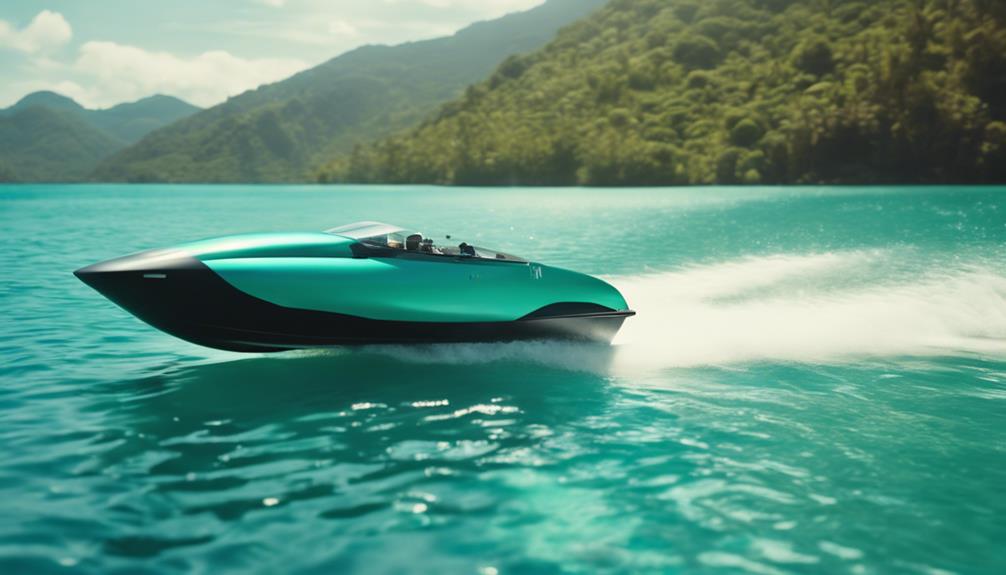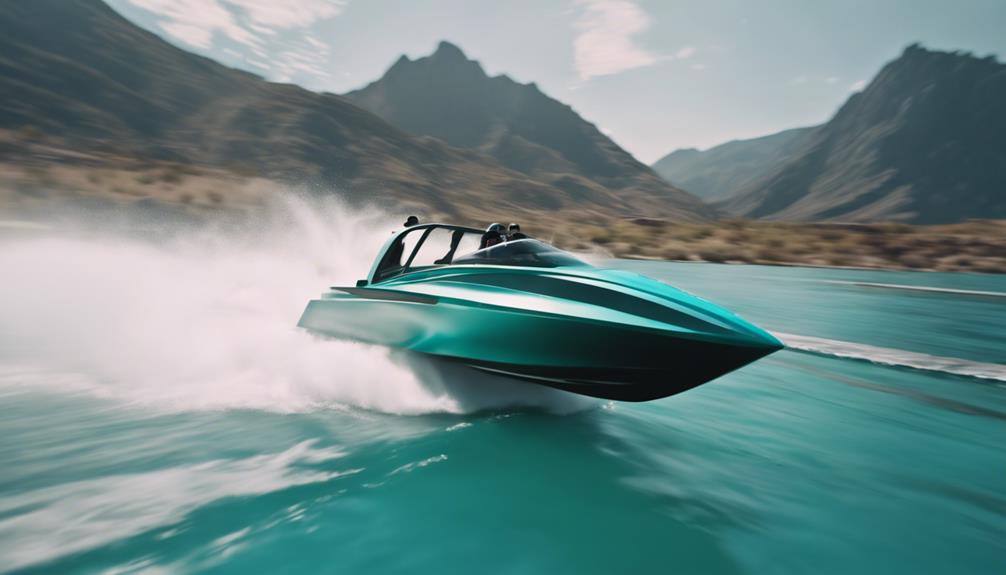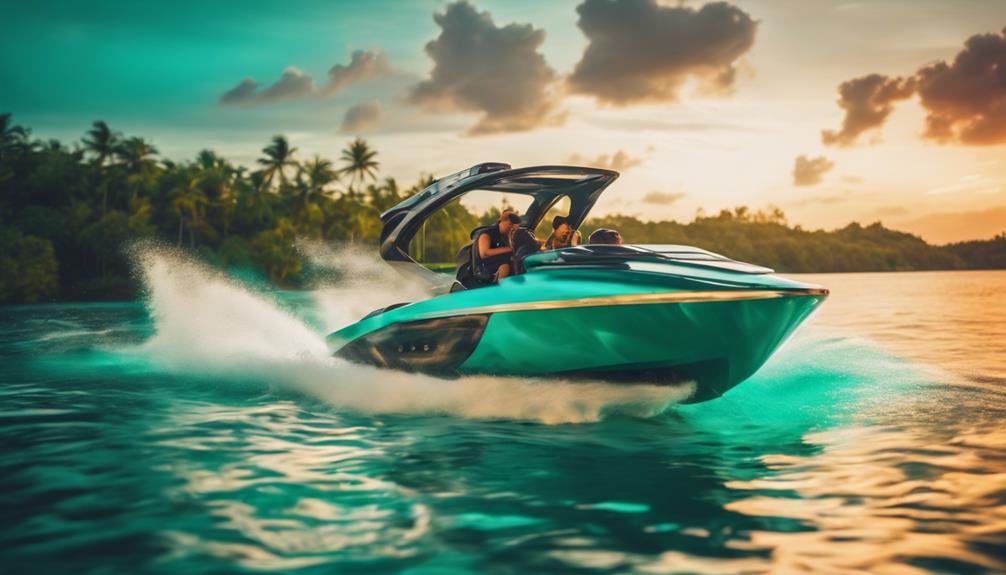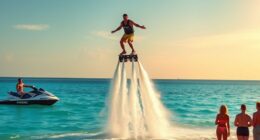When you're ready to buy a jet boat, consider your specific needs and preferences first. Brands like Yamaha and Scarab offer excellent options in varying sizes and performance levels. Think about how many passengers you'll accommodate and your intended water activities, whether it's cruising or watersports. Evaluate horsepower, hull design, and safety features to guarantee ideal handling and enjoyment. Also, keep in mind maintenance requirements and market trends for pricing. Exploring these aspects will help you make an informed decision, leading you to the perfect jet boat for your adventures ahead.
Key Takeaways
- Determine your intended use: recreational cruising, watersports, fishing, or as a tender for larger vessels to guide your choice.
- Assess passenger capacity: select a model that comfortably accommodates your typical number of passengers for enjoyable outings.
- Consider engine performance: evaluate horsepower ratings and jet propulsion systems for the speed and acceleration that meet your needs.
- Compare safety features: ensure essential equipment, like life jackets and fire extinguishers, are included to comply with safety regulations.
Jet Boat Brands Overview
When you're exploring jet boat brands, you'll find a diverse range of options tailored to different needs and preferences, from luxury tenders to rugged fishing boats.
Brands like AB Inflatables and Argo Nautic focus on high-quality jet tenders, providing customizable features that suit your style. AB Inflatables offers models from 9.6 to 15 feet, powered by diesel or gasoline engines, while Argo Nautic's Jet 9.5 and Jet 11 can be tailored to match the aesthetics of larger yachts.
If you're looking for something more adventurous, G3 produces aluminum fishing boats designed specifically for jet outboards. Their Gator Tough Tunnel Jons, ranging from 17 to 20 feet, excel in shallow waters and rocky rivers, making them ideal for fishing enthusiasts.
Scarab stands out with its recreational fiberglass pleasure boats, featuring innovative designs powered by BRP Rotax inboards.
Don't forget Yamaha, a leading brand in the jet boat market. They offer popular models from 19 to 27 feet, known for their high performance and advanced water jet propulsion technology. With Yamaha Marine engines, you can expect reliability and satisfaction on the water.
Key Features to Consider
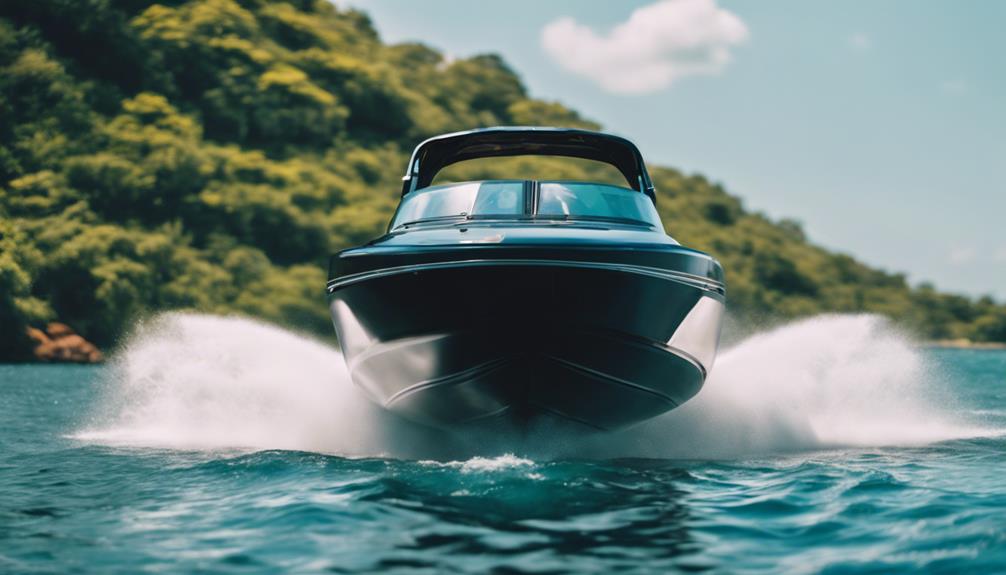
Consider these key features to secure you choose the right jet boat that meets your needs and enhances your on-water experience. Focus on size and capacity to guarantee comfort for your passengers, as jet boats typically range from 19 to 27 feet. Engine performance is vital; higher horsepower ratings, often between 100 to over 300 HP, provide better acceleration and speed for activities like wakeboarding.
Don't overlook hull design, as innovative shapes can improve handling and stability, especially in shallow or rocky waters. Safety features are non-negotiable; look for enclosed jet propulsion systems and essential safety gear, including life jackets and bilge pumps. Finally, consider maintenance requirements; jet boats usually have simpler upkeep due to fewer exposed parts, but be sure to check the intake grate regularly.
| Feature | Importance | Considerations |
|---|---|---|
| Size and Capacity | Comfort for passengers | 19 to 27 feet, varies by model |
| Engine Performance | Acceleration and speed | 100 to 300+ HP ratings |
| Hull Design | Handling and stability | Innovative designs for maneuverability |
| Safety Features | Risk reduction | Enclosed jet systems, essential gear |
| Maintenance Requirements | Ease of upkeep | Regular checks on intake grate |
Performance and Power Options

Jet boats deliver impressive performance and power options, making them perfect for thrill-seekers and water sports enthusiasts alike.
With horsepower ratings ranging from 100 to over 300 HP, these boats can achieve high speeds and rapid acceleration that will get your adrenaline pumping. The jet propulsion systems enhance performance, allowing you to go from zero to high speeds in just seconds—ideal for activities like wakeboarding and tubing.
Many models, such as the Yamaha AR 195, come with supercharged engines that offer exhilarating performance while accommodating up to eight passengers for family adventures. The design of jet boats emphasizes high RPM operation, ensuring efficient power delivery and responsiveness vital for precise control during exciting outings.
To maintain reliability and performance, regular maintenance is key. Check the intake grate and engine condition to optimize your jet boat's capabilities and longevity.
Buying Considerations
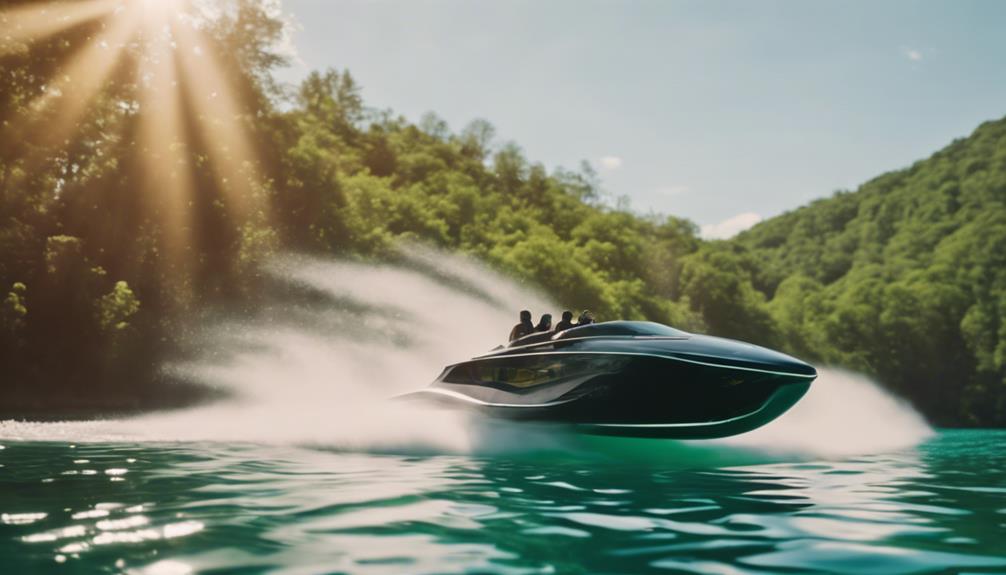
When buying a jet boat, you need to assess how you'll use it—whether for thrilling watersports or relaxing family outings.
Comparing model features is vital to guarantee you find a boat that matches your speed and handling expectations.
Intended Use Assessment
Evaluating your intended use for a jet boat is vital, as it will determine the size and features that best suit your needs.
First, think about how you'll primarily use the boat—whether it's for recreational cruising, watersports, fishing, or even as a tender for a larger vessel. Each purpose demands different specifications.
Next, consider the typical passenger load you'll have on board. Jet boats vary in capacity, accommodating anywhere from 4 to over 13 people, so choose a model that guarantees comfort for everyone during outings.
Water conditions also play an important role in your decision. If you plan to navigate shallow waters, lighter models are ideal, while more robust designs are suited for rougher or deeper environments.
Lastly, identify your performance needs. If you're into watersports, you'll want a boat with speed and agility. For fishing trips, stability and ample storage are key.
Model Features Comparison
Understanding the various model features is key to making an informed decision that aligns with your intended use and preferences. Jet boats offer a range of configurations, so it's essential to compare them based on what matters most to you.
Start by evaluating the seating capacity and layout. For instance, the Yamaha AR 195 seats up to 8 and boasts a supercharged engine, while the Scarab 255 ID can accommodate 13 with luxurious features and an impressive 600 HP.
Next, consider the propulsion systems; models like the G3 Gator Tough Tunnel Jon are tailored for shallow waters, whereas Scarab boats utilize BRP Rotax inboards for enhanced recreational performance.
Don't overlook storage options and overall design. Scarab's compact 165 ID features clever storage solutions, while the Sea Doo Switch has a modular deck layout that improves usability.
Finally, assess the performance specifications—Yamaha's SX195 blends family-friendly features with agile handling, contrasting sharply with the high-speed capabilities of the Scarab 255 ID.
Safety Features and Maintenance

Safety and maintenance are essential for guaranteeing your jet boat performs reliably and keeps everyone on board secure. When choosing a jet boat, pay attention to its safety features and develop a solid maintenance routine. Here are three significant aspects to take into account:
- Safety Equipment: Verify your jet boat comes with mandatory safety gear, such as life jackets, fire extinguishers, and functional navigation lights. These features help you comply with boating regulations while enhancing safety.
- Propulsion System: Look for boats equipped with jet drives, which have enclosed propulsion systems that minimize risks from underwater obstacles. This design is safer for swimmers and water sports enthusiasts alike.
- Intake Grate Maintenance: Regularly check the intake grate for debris that can clog the propulsion system. Keeping it clean guarantees peak performance and safety during operation.
Additionally, a functional bilge pump is essential for removing water from the boat, further contributing to its reliability.
Condition and Inspection Tips

When inspecting a jet boat, focus on the hull's condition to identify any visible damage like scratches, dents, or cracks that could signal deeper issues.
Pay close attention to the hull shape—any irregularities might affect performance. Look for signs of delamination or blistering, which can compromise the boat's structural integrity.
Next, evaluate the interior for wear and tear, especially the upholstery. Signs of neglect could indicate poor maintenance history.
Don't forget to check the functionality of essential components, such as lights, switches, and steering mechanisms; everything should operate smoothly without interference.
Inspect the impeller for any signs of damage. Excessive play in all directions can signal pump issues that may hurt the jet drive's performance.
Make sure the impeller is in good shape to guarantee peak functionality.
Market Trends and Pricing
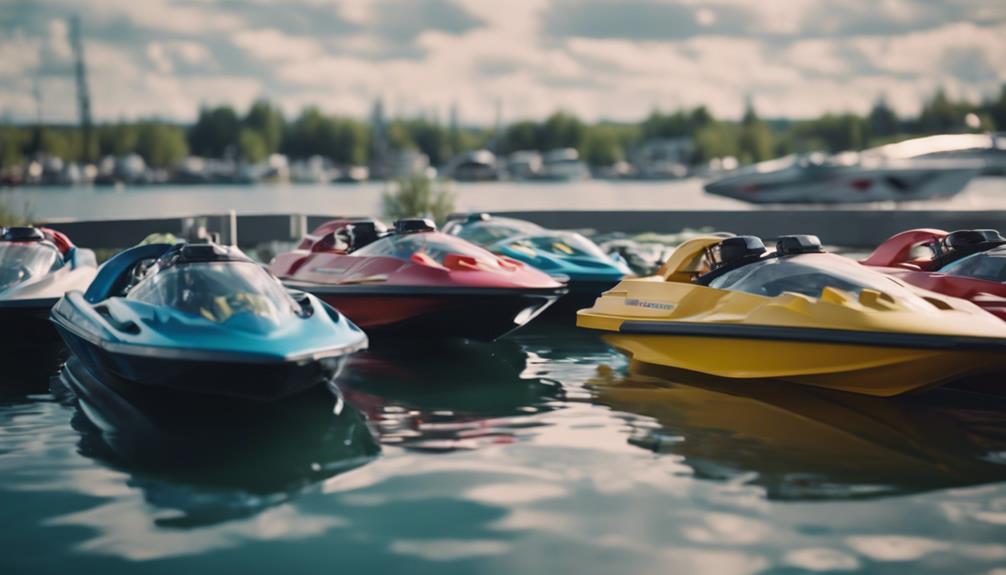
When you're considering a jet boat purchase, it's essential to understand current pricing trends and popular brands.
You'll find entry-level options starting around $20,000, while luxury models can soar beyond $100,000.
Keep an eye on seasonal sales too, as they often present great opportunities for savings.
Current Pricing Trends
Jet boat prices vary widely, starting around $20,000 for entry-level models and soaring beyond $100,000 for luxury options, reflecting the diverse features and brand reputations in the market. When evaluating your purchase, it's crucial to keep current pricing trends in mind, as they can considerably impact your decision.
Here are three key factors to evaluate:
- Seasonal Trends: Prices often drop at the end of the boating season. Sellers are keen to clear inventory, which means you might snag a great deal if you time your purchase right.
- Average Price Range: Popular brands like Yamaha, Sea-Doo, and Scarab typically offer mid-tier models priced between $30,000 and $60,000. Understanding this range helps you gauge what to expect.
- Financing Options: Many dealers and banks provide financing options with competitive interest rates, allowing you to spread the cost over time.
Utilizing market research tools, like NADA guides, can help you assess fair pricing based on model year, condition, and features, ensuring you make an informed purchase decision.
Popular Brands Overview
In today's competitive market, popular brands like Yamaha, Scarab, and Sea-Doo dominate the jet boat scene, each offering unique features that cater to different boating preferences and budgets.
Yamaha leads the pack with models ranging from 19 to 27 feet, known for their performance and innovative designs. Customers often praise Yamaha for high satisfaction ratings, making it a reliable choice.
Scarab focuses on recreational fiberglass jet boats, with models like the 165 ID and 255 ID. These boats are recognized for their speed and agility, appealing to both thrill-seekers and families looking for luxury features.
Sea-Doo combines pontoon and jet boat elements in models like the Switch, presenting modular designs that cater to the versatile watercraft market.
If you're considering something more rugged, G3 specializes in aluminum jet boats, particularly the Gator Tough Tunnel Jons, ideal for fishing and hunting enthusiasts. These boats are competitively priced and designed for shallow waters.
Lastly, don't overlook AB Inflatables, which offers stylish jet tenders in their Jet Tender series, perfect for luxury boat owners.
Each brand has something special to offer, so assess your needs before making a decision.
Seasonal Sales Opportunities
Taking advantage of seasonal sales opportunities can lead to significant savings on your next jet boat purchase. The best times to buy are typically at the end of summer and during the fall. Sellers aim to offload their inventory before winter, often resulting in discounts of 10-20% off MSRP.
Here are three key points to reflect on:
- Boat Shows: These events are prime for snagging promotional pricing and incentives from manufacturers and dealers, helping you secure favorable deals.
- Off-Season Purchasing: Buying during the late fall or winter, when demand drops, allows you to compare prices across various dealers, increasing your chances of finding markdowns on last year's models.
- Financing Promotions: During the off-season, you'll often encounter trade-in offers and financing promotions, giving you leverage to negotiate better terms and lower overall costs.
Financing and Insurance Options

When considering financing and insurance options for your new boat, it's crucial to understand the available choices and how they can impact your budget. Many boat dealerships offer financing options with competitive interest rates, typically ranging from 4% to 8%, depending on your credit score and loan terms. The average loan term for a jet boat can range from 5 to 20 years, allowing you to tailor your payments to fit your financial situation.
When it comes to boat insurance, costs usually range from 1% to 3% of the boat's value annually. Factors like size, type, usage, and your claims history influence your premium. Don't forget to explore discounts; completing boating safety courses can reduce your premiums by up to 10%.
Here's a quick comparison of financing and insurance factors:
| Financing Options | Boat Insurance |
|---|---|
| Interest Rates: 4%-8% | Annual Cost: 1%-3% |
| Loan Terms: 5-20 years | Discounts for Safety Courses |
| Shop for Insurance Quotes | |
| Claims History Affects Rates |
Taking the time to compare insurance quotes can save you hundreds, ensuring you get the best deal.
Recommended Jet Boat Models
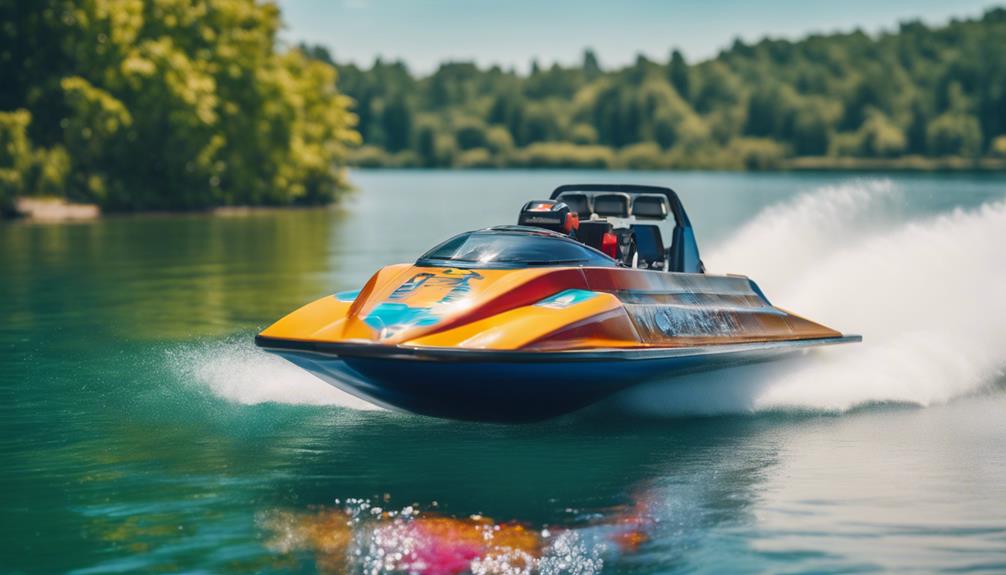
If you're looking for the perfect jet boat, there are several standout models that cater to a variety of needs and preferences. Here's a quick overview of three excellent choices that combine performance, comfortable seating, and impressive acceleration, making them great for water sports:
- Yamaha AR 195: This model seats up to 8 passengers comfortably and features a supercharged 4-cylinder engine. It delivers thrilling performance with impressive acceleration, perfect for those who crave excitement on the water.
- Scarab 255 ID: With luxurious seating for 13 and a powerful 600 HP engine, this jet boat offers versatility and comfort, ensuring you and your guests enjoy every outing. It's designed for maximum enjoyment while engaging in various water sports.
- Chaparral Vortex 2430 VRX: This stylish boat provides twin engine options, which guarantee impressive acceleration and handling. It's a fantastic choice for recreational boating, blending performance with a sleek aesthetic.
Each of these jet boats has unique features, so consider your specific needs to find the perfect fit for your adventures on the water!
Frequently Asked Questions
Who Makes the Most Reliable Jet Boats?
When you're looking for reliable jet boats, consider Yamaha for innovative design, Scarab for stylish performance, and Sea-Doo for versatility. Each brand offers unique features, ensuring you find a dependable option that suits your needs.
Do Yamaha Jet Boats Hold Their Value?
Imagine selling your Yamaha jet boat years later and recouping 60-70% of its value. Yes, Yamaha jet boats do hold their value well due to their reliability, innovative features, and strong resale demand.
What Is the Best Jet Boat for Water Skiing?
When you're looking for the best jet boat for water skiing, consider models like the Yamaha 255 FSH Sport or Scarab 255 ID. They offer power, stability, and features that enhance your skiing experience.
What Is the Average Cost of a Jet Boat?
Buying a jet boat can feel like shopping for a new car; prices range from about $20,000 for entry-level models to over $100,000 for luxury versions, plus additional costs for insurance and maintenance.
Can the Ultimate Buyer’s Guide for Jet Boats also include essential tips for buying a jet boat?
Yes, the Ultimate Buyer’s Guide for Jet Boats should definitely include essential tips for buying a jet boat. These essential tips for buying a jet boat can help new buyers make informed decisions and avoid common mistakes. It’s crucial to have all the necessary information before making a big purchase like a jet boat.
Conclusion
Choosing the right jet boat can feel like finding a needle in a haystack, but it doesn't have to be that complicated!
By considering the key features, performance options, and safety measures we've discussed, you'll be well-equipped to make an informed decision.
Whether you're cruising on calm waters or racing through waves, the perfect jet boat is out there waiting for you.
So get ready to make a splash and hit the water with confidence!

